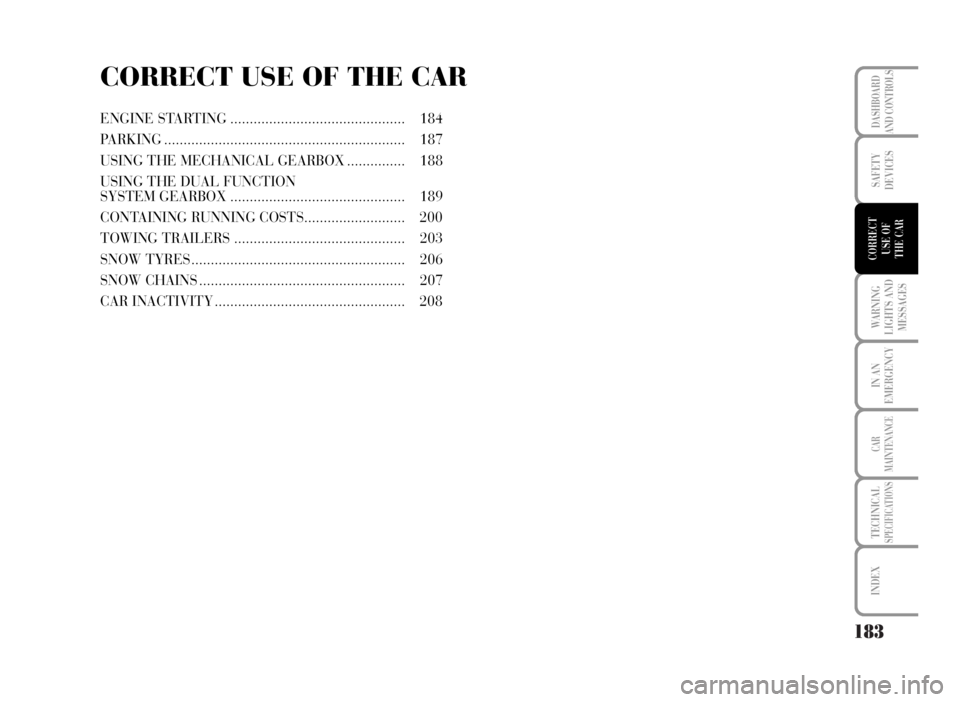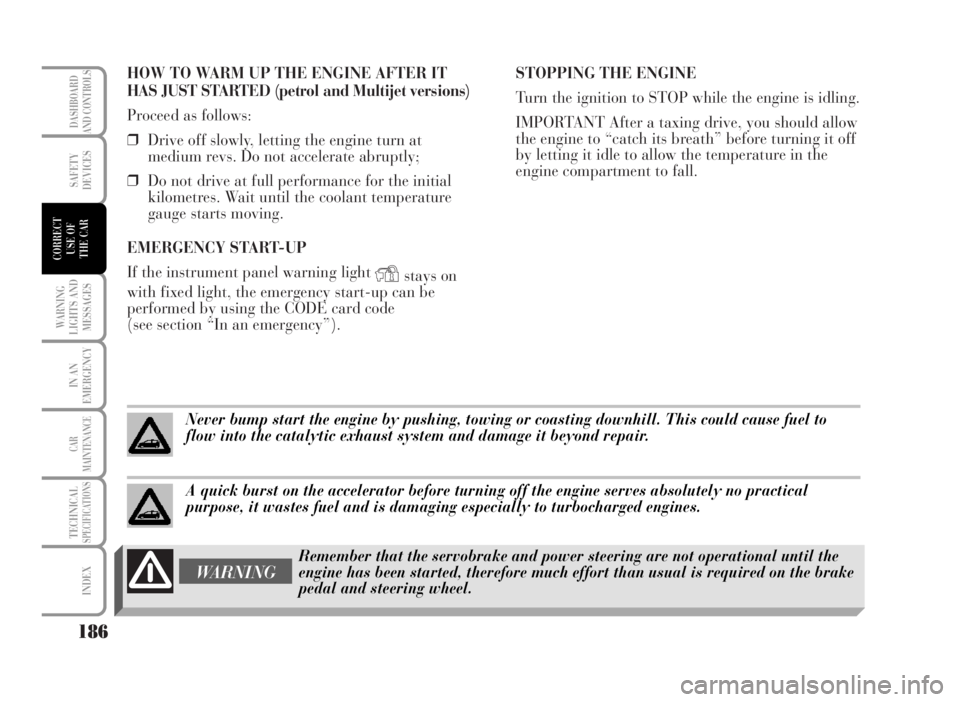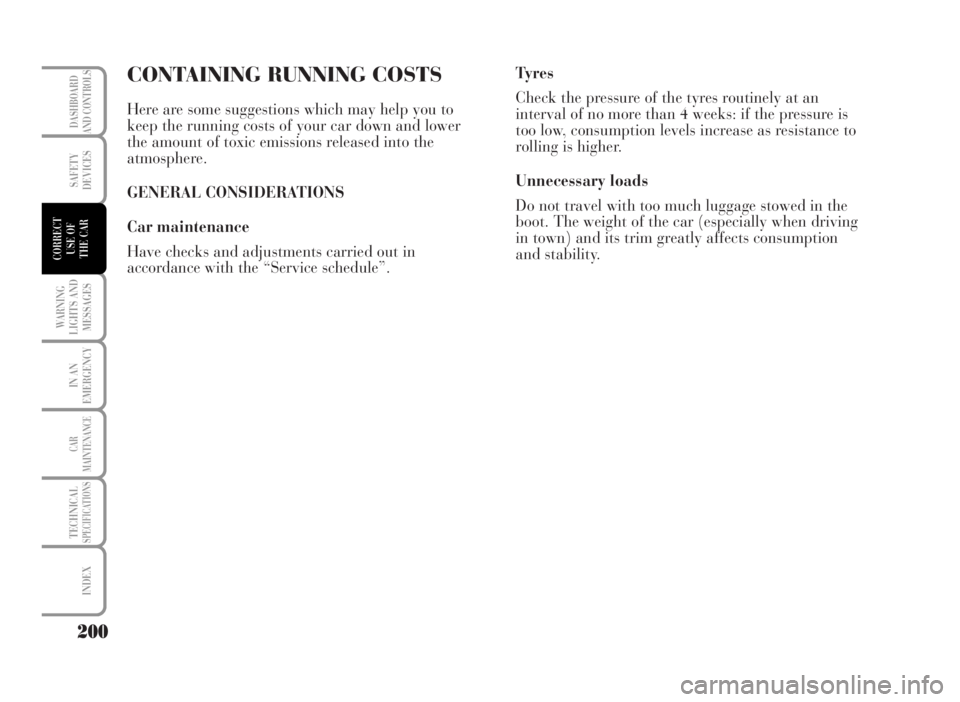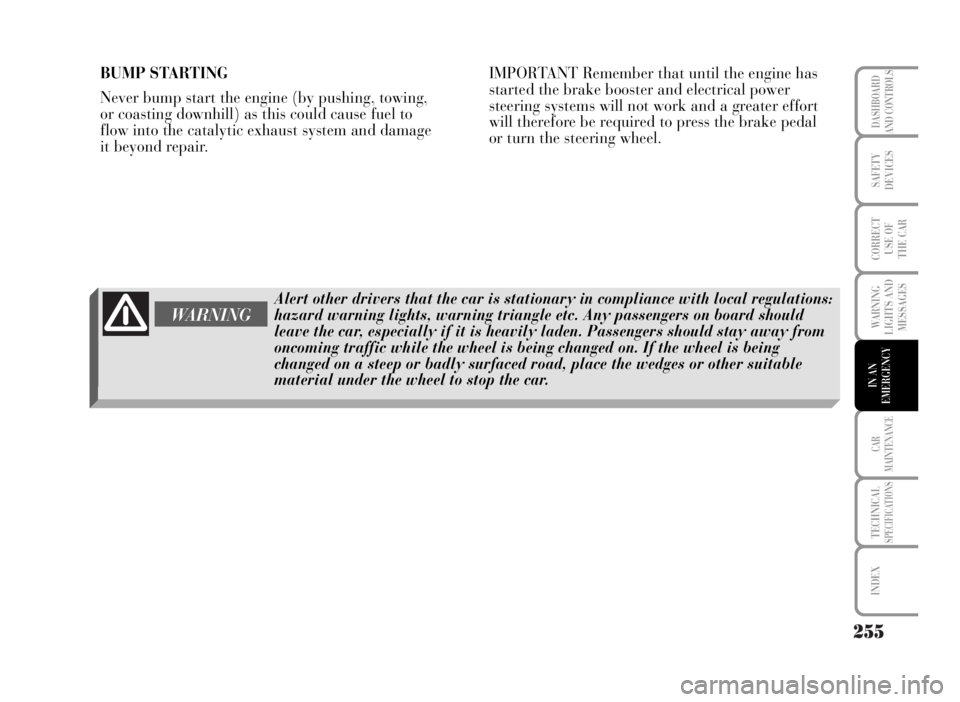tow Lancia Musa 2007 Owner handbook (in English)
[x] Cancel search | Manufacturer: LANCIA, Model Year: 2007, Model line: Musa, Model: Lancia Musa 2007Pages: 346, PDF Size: 5.15 MB
Page 154 of 346

FAILURE WARNINGS
See the “Warning lights and messages” chapter.
OPERATION WITH TRAILER
The system is preset for deactivating automatically
when the trailer electric cable plug is fitted into the
car tow hook socket.
Sensors are reactivated when removing the trailer
cable plug.GENERAL WARNINGS
❒When parking, take the utmost care to obstacles
set above or under the sensors.
❒Objects set close to car rear part, under certain
circumstances are not detected and could
therefore cause damages to the car.
❒Indications sent by the sensor can be altered by
dirt, snow or ice deposited on the sensors or by
ultrasound systems (e.g.: truck pneumatic
brakes or pneumatic hammers) set nearby the
car.
153
SAFETY
DEVICES
CORRECT
USE OF
THE CAR
WARNING
LIGHTS AND
MESSAGES
IN AN
EMERGENCY
CAR
MAINTENANCE
TECHNICALSPECIFICATIONS
INDEX
DASHBOARD
AND
CONTROLS
For proper operation, the parking sensors set on the bumpers shall be clean from mud, dirt, snow
or ice. When cleaning the sensors, take the utmost care to prevent their damaging; do not use
therefore dry or rough clothes. Sensors shall be washed with clean water and car detergent, if
required. In washing stations, clean sensors quickly keeping the vapour jet/high pressure washing
nozzles at 10 cm at least from the sensors.
WARNING
Parking manoeuvres however are always under the driver’s responsibility that
shall always check the absence of people, animals or objects in the manoeuvre
space. This system is just a help for the driver but he shall never reduce
important during dangerous manoeuvres even if performed at low speed.
Page 184 of 346

183
WARNING
LIGHTS AND
MESSAGES
IN AN
EMERGENCY
CAR
MAINTENANCE
TECHNICALSPECIFICATIONS
INDEX
DASHBOARD
AND CONTROLS
SAFETY
DEVICES
CORRECT
USE OF
THE CAR
ENGINE STARTING ............................................. 184
PARKING .............................................................. 187
USING THE MECHANICAL GEARBOX ............... 188
USING THE DUAL FUNCTION
SYSTEM GEARBOX ............................................. 189
CONTAINING RUNNING COSTS.......................... 200
TOWING TRAILERS ............................................ 203
SNOW TYRES ....................................................... 206
SNOW CHAINS ..................................................... 207
CAR INACTIVITY ................................................. 208
CORRECT USE OF THE CAR
Page 187 of 346

HOW TO WARM UP THE ENGINE AFTER IT
HAS JUST STARTED (petrol and Multijet versions)
Proceed as follows:
❒Drive off slowly, letting the engine turn at
medium revs. Do not accelerate abruptly;
❒Do not drive at full performance for the initial
kilometres. Wait until the coolant temperature
gauge starts moving.
EMERGENCY START-UP
If the instrument panel warning light
Ystays on
with fixed light, the emergency start-up can be
performed by using the CODE card code
(see section “In an emergency”).STOPPING THE ENGINE
Turn the ignition to STOP while the engine is idling.
IMPORTANT After a taxing drive, you should allow
the engine to “catch its breath” before turning it off
by letting it idle to allow the temperature in the
engine compartment to fall.
186
WARNING
LIGHTS AND
MESSAGES
IN AN
EMERGENCY
CAR
MAINTENANCE
TECHNICALSPECIFICATIONS
INDEX
DASHBOARD
AND CONTROLS
SAFETY
DEVICES
CORRECT
USE OF
THE CAR
Never bump start the engine by pushing, towing or coasting downhill. This could cause fuel to
flow into the catalytic exhaust system and damage it beyond repair.
A quick burst on the accelerator before turning off the engine serves absolutely no practical
purpose, it wastes fuel and is damaging especially to turbocharged engines.
Remember that the servobrake and power steering are not operational until the
engine has been started, therefore much effort than usual is required on the brake
pedal and steering wheel.
WARNING
Page 201 of 346

CONTAINING RUNNING COSTS
Here are some suggestions which may help you to
keep the running costs of your car down and lower
the amount of toxic emissions released into the
atmosphere.
GENERAL CONSIDERATIONS
Car maintenance
Have checks and adjustments carried out in
accordance with the “Service schedule”.Tyres
Check the pressure of the tyres routinely at an
interval of no more than 4 weeks: if the pressure is
too low, consumption levels increase as resistance to
rolling is higher.
Unnecessary loads
Do not travel with too much luggage stowed in the
boot. The weight of the car (especially when driving
in town) and its trim greatly affects consumption
and stability.
200
WARNING
LIGHTS AND
MESSAGES
IN AN
EMERGENCY
CAR
MAINTENANCE
TECHNICALSPECIFICATIONS
INDEX
DASHBOARD
AND CONTROLS
SAFETY
DEVICES
CORRECT
USE OF
THE CAR
Page 204 of 346

TOWING TRAILERS
IMPORTANT NOTES
For towing caravans or trailers the car must be
fitted with a certified tow hook and an adequate
electric system. Installation should be carried out by
specialised personnel who release a special
document for circulation on the road.
Install any specific and/or additional rear-view
mirrors as specified by law.
Remember that when towing a trailer, steep hills are
harder to climb, the braking spaces increase and
overtaking takes longer depending on the overall
weight.Engage a low gear when driving downhill, rather
than constantly using the brake.
The weight the trailer exerts on the car tow hook
reduces by the same amount the actual vehicle
loading capacity. To make sure the maximum
towable weight is not exceeded (given in the log
book) account should be taken of the fully laden
trailer, including accessories and personal
belongings.
Do not exceed the speed limits of the country you
are driving in. In any case do not exceed 100 km/h.
203
WARNING
LIGHTS AND
MESSAGES
IN AN
EMERGENCY
CAR
MAINTENANCE
TECHNICALSPECIFICATIONS
INDEX
DASHBOARD
AND CONTROLS
SAFETY
DEVICES
CORRECT
USE OF
THE CAR
WARNING
Under no circumstances should the vehicle brake system be altered to control the
trailer brake. The trailer braking system must be fully independent of the vehicle’s
hydraulic system.
WARNING
The ABS system with which the car may be fitted does not control the trailer braking
system. Great care should therefore be taken when driving on slippery road surfaces.
Page 205 of 346

INSTALLING THE TOW HOOK
The towing device should be fastened to the body
by specialised personnel according to any additional
and/or integrative information supplied by the
Manufacturer of the device.
The towing device must meet current regulations
with reference to 94/20/EC Directive and
subsequent amendments.
For any version the towing device used must match
the towable weight of the vehicle on which it is to
be installed.
For the electric connection a unified connector
should be used which is generally placed on a
special bracket normally fastened to the towing
device, and a special ECU for external trailer light
control shall be installed on the car. For the electrical connection 7 or 13 pins 12VDC
connection is to be used (CUNA/UNI and ISO/DIN
Standards). Follow the instructions provided by the
car manufacturer and/or the tow hitch
manufacturer.
An electric brake should be supplied directly by the
battery through a cable with a cross section of no
less than 2.5 mm
2.
IMPORTANT Electric brake or other device shall be
used with running engine.
In addition to the electrical branches, the car’s
electric system can only be connected to the supply
cable for an electric brake and to the cable for an
internal light, though not above 15W.
For connections use a preset control unit with
battery cable no less than 2.5 mm
2.
204
WARNING
LIGHTS AND
MESSAGES
IN AN
EMERGENCY
CAR
MAINTENANCE
TECHNICALSPECIFICATIONS
INDEX
DASHBOARD
AND CONTROLS
SAFETY
DEVICES
CORRECT
USE OF
THE CAR
Page 206 of 346

ASSEMBLY DIAGRAM
The tow hook structure must be fastened in the
points shown by the symbolØusing a total of 4
M8 screws, 2 M10 screws and 2 M12 screws.
The hook should be fastened to the body avoiding
any type of drilling and trimming of the rear
bumpers that remains visible when the hook is
removed.
IMPORTANT It is compulsory to fasten a label
(plainly visible) of suitable size and material with
the following wording:
MAX LOAD ON BALL 60 kg
205
WARNING
LIGHTS AND
MESSAGES
IN AN
EMERGENCY
CAR
MAINTENANCE
TECHNICALSPECIFICATIONS
INDEX
DASHBOARD
AND CONTROLS
SAFETY
DEVICES
CORRECT
USE OF
THE CAR
After fitting, screw holes shall be sealed to prevent exhaust gas inlet.WARNING
L0D0256m
Existing holes
Existing holes
Existing holesStandard ball
Full load
Page 217 of 346

216
IN AN
EMERGENCY
CAR
MAINTENANCE
TECHNICALSPECIFICATIONS
INDEX
DASHBOARD
AND CONTROLS
SAFETY
DEVICES
CORRECT
USE OF
THE CAR
WARNING
LIGHTS AND
MESSAGES
Warning
light on
dialMessage on
multifunction
display
❒car heavy duty(e.g.: towing trailer uphill or fully laden car):
decrease speed, if the warning light stays on, stop the car. Wait for
2 or 3 minutes leaving the engine on and slightly accelerated to
further activate the circulation of the coolant fluid, then switch the
engine off. Check proper coolant level as described previously.
IMPORTANT Under severe use of the car, keep the engine on and
slightly accelerated for few minutes before switching it off.ç
continued from previous page
red
Page 252 of 346

251
WARNING
LIGHTS AND
MESSAGES
CAR
MAINTENANCE
TECHNICALSPECIFICATIONS
INDEX
DASHBOARD
AND CONTROLS
SAFETY
DEVICES
CORRECT
USE OF
THE CAR
IN AN
EMERGENCY
IN AN EMERGENCY
DOOR OPENING/CLOSING ................................. 252
ENGINE STARTING ............................................. 253
QUICK TYRE REPAIR KIT
FIX & GO automatic ............................................... 256
IF A TYRE IS PUNCTURED ................................. 261
WHEN NEEDING TO CHANGE A BULB ............ 268
IF AN EXTERIOR LIGHT BURNS OUT ............... 271
IF AN INTERIOR LIGHT BURNS OUT ................ 277
IF A FUSE BLOWS ............................................... 280
IF THE BATTERY IS FLAT .................................. 286
JACKING THE CAR .............................................. 287
TOWING THE CAR ............................................. 287
Page 256 of 346

255
WARNING
LIGHTS AND
MESSAGES
CAR
MAINTENANCE
TECHNICALSPECIFICATIONS
INDEX
DASHBOARD
AND CONTROLS
SAFETY
DEVICES
CORRECT
USE OF
THE CAR
IN AN
EMERGENCY
BUMP STARTING
Never bump start the engine (by pushing, towing,
or coasting downhill) as this could cause fuel to
flow into the catalytic exhaust system and damage
it beyond repair.IMPORTANT Remember that until the engine has
started the brake booster and electrical power
steering systems will not work and a greater effort
will therefore be required to press the brake pedal
or turn the steering wheel.
WARNING
Alert other drivers that the car is stationary in compliance with local regulations:
hazard warning lights, warning triangle etc. Any passengers on board should
leave the car, especially if it is heavily laden. Passengers should stay away from
oncoming traffic while the wheel is being changed on. If the wheel is being
changed on a steep or badly surfaced road, place the wedges or other suitable
material under the wheel to stop the car.